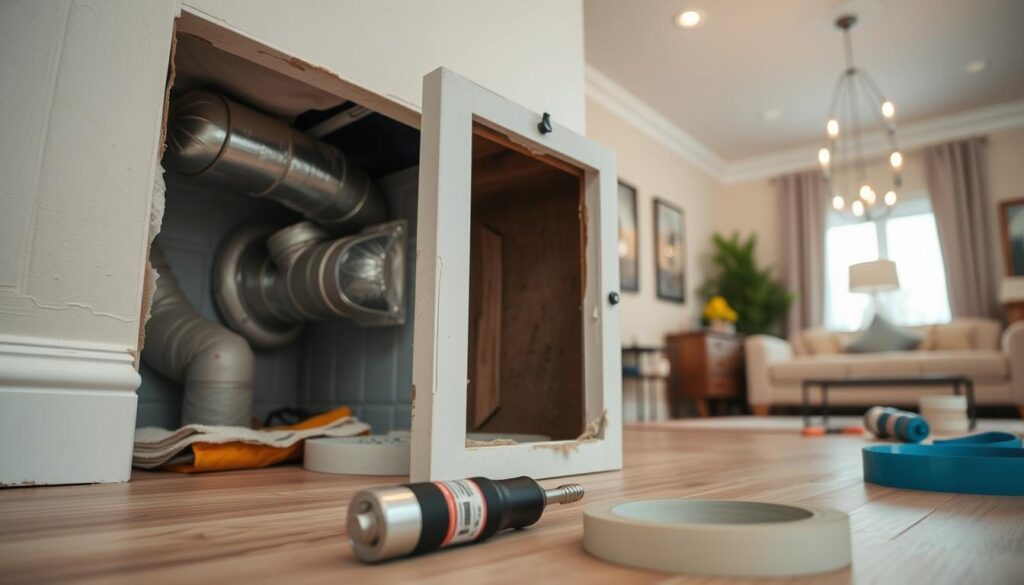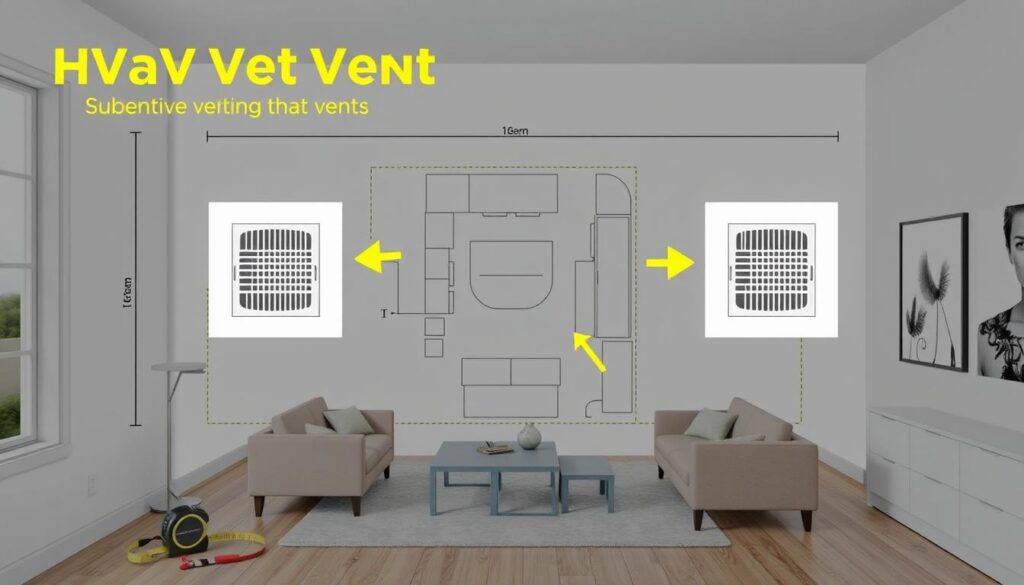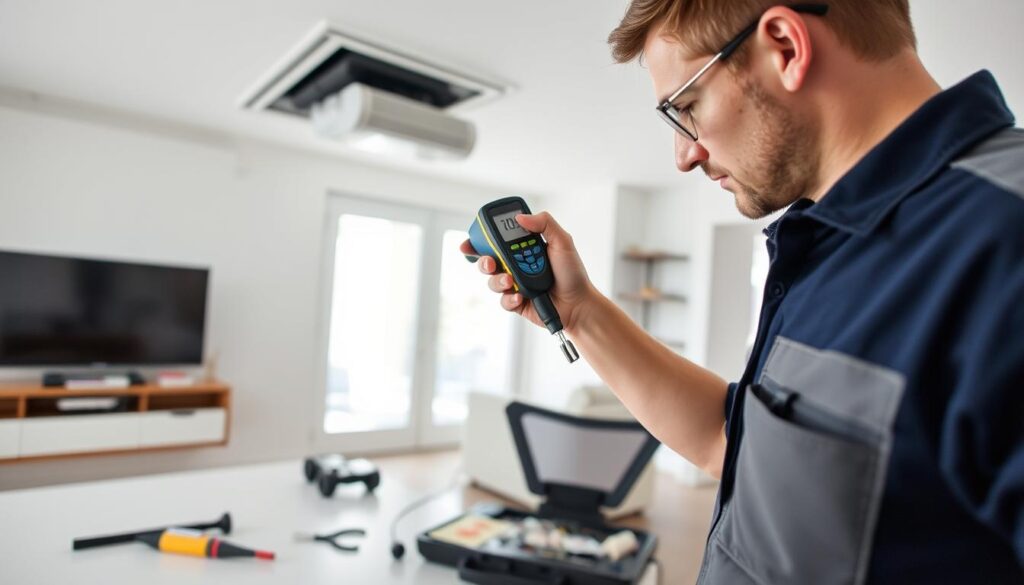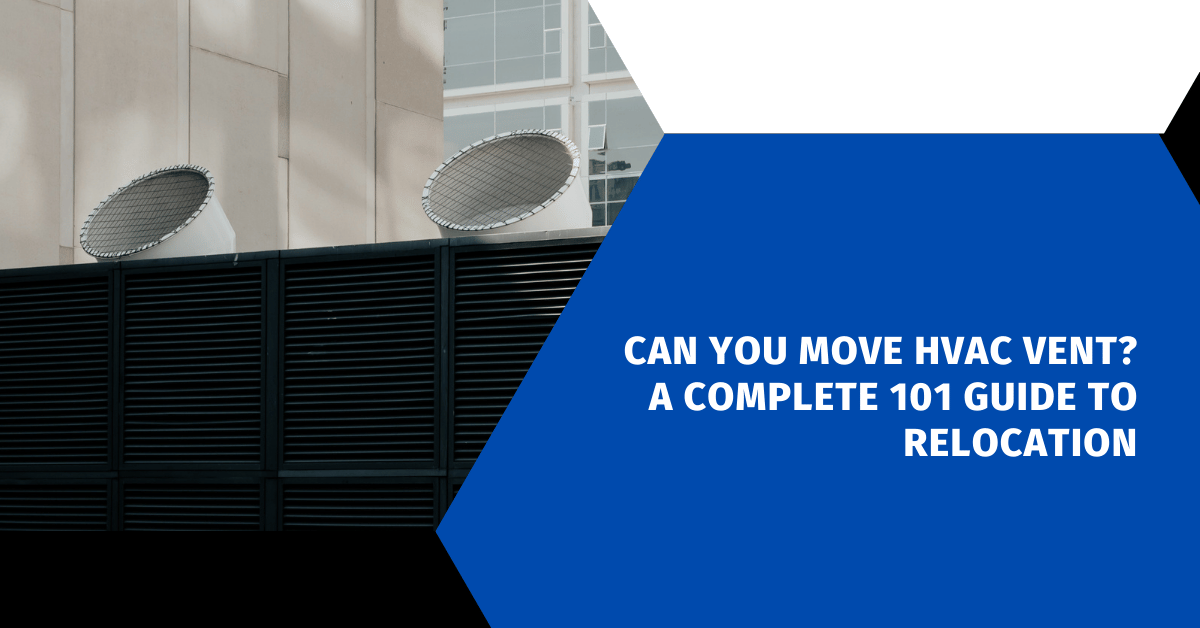Affiliate Disclosure
HVAC Guide Guys is a participant in the Amazon Services LLC Associates Program, an affiliate advertising program designed to provide a means for sites to earn advertising fees by advertising and linking to Amazon.
Can You Move HVAC Vent? As the weather gets colder, you might look at that HVAC vent and think it should be somewhere else. Moving an air vent seems easy, but it’s important to know what it means before you start.

This guide will cover everything about moving HVAC vents. We’ll talk about the parts of the system, safety, and legal stuff. If you want better airflow, a nicer room, or are doing a big renovation, we’ve got you covered.
Key Takeaways
- HVAC vent relocation can be a complex process that requires careful planning and professional expertise.
- Factors like pipe length, number of turns, and building codes must be considered to ensure system performance and safety.
- Relocating an HVAC vent can be a significant investment, with costs ranging from a few hundred to a few thousand dollars.
- Proper permits and professional certifications are often required for HVAC vent relocation projects.
- Post-installation testing and verification are crucial to ensure the newly relocated vent functions as intended.
Table of Contents
Understanding HVAC Vent Systems and Their Components
To move HVAC vents, knowing the parts and types is key. HVAC systems are vital for air in homes. They keep us comfortable and the air clean.
Types of HVAC Vents
HVAC vents vary in shape and size. Each has a unique role. Here are some common ones:
- Supply Vents: These send out the cooled or heated air from the system.
- Return Vents: They pull air back to the system for recirculation.
- Exhaust Vents: These remove stale air, like in kitchens and bathrooms.
Common Vent Locations in Homes
Vents are found in many spots in homes. Here are a few:
- Floors: Vents near windows or seats to reach people.
- Walls: Vents at eye level for balanced air.
- Ceilings: Used in tall rooms or open spaces.
Basic Components of Ventilation Systems
HVAC systems have important parts. Here’s a list:
| Component | Description |
|---|---|
| Ductwork | The air ducts that carry air from the unit to vents. |
| Blower Fan | The fan that moves air through ducts and vents. |
| Thermostat | The control that sets the temperature and runs the system. |
| Filters | They clean the air of dirt and dust before it’s sent out. |
Knowing about HVAC vents and their parts helps when moving them. It’s all about making smart choices.
Explore Our HVAC Shop
Looking for top-rated HVAC tools, parts, and accessories? Visit our shop and find the perfect solution for your needs.
Visit the ShopCan You Move HVAC Vent: Safety and Feasibility Assessment
Relocating an HVAC vent is a complex task. It needs careful safety and feasibility checks. Always check the furnace’s manual and manufacturer guidelines first. This ensures your HVAC system works safely and efficiently.
When moving vents, consider how it affects system performance. Vent length, bends, and system setup can impact airflow and safety. Wrong vent placement can also raise energy costs.
Also, make sure the vent move follows local building codes. These codes cover vent placement, size, and materials. Not following them can lead to fines, system failures, and legal issues.
| Statistic | Value |
|---|---|
| Published on | May 6, 2020 |
| Article Accesses | 60,000 |
| Citations Received | 70 |
| Altmetric Indicators | 7 |
Improper HVAC vent relocation poses serious risks. It can spread airborne diseases. Ensuring your HVAC vent works right is key to a healthy indoor space.
Before moving vents, assess the risks and feasibility. Follow manufacturer guidelines and local codes. This way, you can safely and effectively move your HVAC vents.
Explore Our HVAC Shop
Looking for top-rated HVAC tools, parts, and accessories? Visit our shop and find the perfect solution for your needs.
Visit the ShopProfessional Requirements and Building Codes
Understanding HVAC vent relocation projects means knowing local building rules and professional certifications. It’s a complex area, but crucial for your home’s ventilation system safety and efficiency.
Local Building Regulations
Every state, county, and city has its own HVAC rules and permits. For example, in Central Ohio, a permit can cost between $75 and $250. In California, ignoring these rules can lead to fines and even jail time.
Permit Requirements
- HVAC projects, like moving a furnace or condenser unit, need a permit.
- The permitting process includes inspections to check for safety and performance.
- Getting the right permits is key, especially when selling a home, to avoid delays.
Professional Certifications Needed
To ensure your HVAC project is done right, hire a certified contractor. In Ohio, you need five years of experience and pass a 10-hour test to get licensed. Working with an unlicensed contractor can lead to legal trouble.
“Quality repercussions: HVAC equipment should last 15-20 years. But bad installations can mean constant repairs or early replacements.”
Choosing a licensed and certified HVAC pro ensures your project meets all standards. This avoids legal problems and keeps your home comfortable.
Planning Your HVAC Vent Relocation Project
Relocating an HVAC vent can be tricky, but with good planning, it can go smoothly. Start by checking your current HVAC system and finding the best spot for the new vent. Look at the furnace’s manual for rules on vent size, fittings, and outdoor setup for different setups.
When planning your HVAC vent planning, think about a few things:
- Where the vent is now and how easy it is to move
- Where you want the vent to be and how it will affect airflow
- Changes needed to the ductwork and wiring
- Local building codes and permits you might need
- How moving the vent might affect your HVAC system
It’s crucial to team up with a licensed HVAC pro for safe and right HVAC vent planning and vent relocation process. They can offer great advice, make sure you follow the rules, and help you get through the project’s tough parts.
“Proper planning is the key to a successful HVAC vent relocation project. By working with a qualified professional, you can ensure your system continues to operate efficiently and effectively.”
Planning your HVAC vent move also means thinking about how it will change your system’s performance. You might need new gear or changes, and there’s the cost to consider. By thinking about all these, you can make sure the move goes well and improves your HVAC system’s performance.

Explore Our HVAC Shop
Looking for top-rated HVAC tools, parts, and accessories? Visit our shop and find the perfect solution for your needs.
Visit the ShopImpact of Vent Length and Turns on System Performance
The number of turns in the piping is more important than the length of the vents for HVAC system performance. The installation manual gives data on pipe sizing, allowed fittings, and installation methods. If you need to extend the HVAC pipe, you might have to upsize the whole pipe to keep efficiency high.
Maximum Allowable Pipe Lengths
HVAC systems have strict rules for the maximum pipe lengths for best performance. Going over these limits can cut airflow, lower efficiency, and even cause equipment failure. Always follow the manufacturer’s guidelines for any vent relocation project.
Effects of Elbows and Bends
The number of elbows and bends in ductwork greatly affects system efficiency. Each bend or turn adds resistance, limiting airflow and making the HVAC equipment work harder. Using fewer elbows and long-radius bends helps keep the system running well.
System Efficiency Considerations
Adding more elbows and bends or extending the HVAC pipe can lower system efficiency. This can raise energy use, increase bills, and reduce home comfort. When moving vents, think about how it will affect efficiency to ensure good performance and energy savings.
| Vent Component | Impact on System Performance |
|---|---|
| HVAC Pipe Length | Longer pipes can restrict airflow and reduce efficiency |
| Elbows and Bends | Each turn creates resistance, forcing the system to work harder |
| System Efficiency | Decreased efficiency leads to higher energy costs and reduced comfort |
“Proper duct design and installation are critical for maintaining HVAC system efficiency and indoor comfort. Minimizing the number of elbows and using the shortest possible pipe lengths can help optimize your system’s performance.”
Explore Our HVAC Shop
Looking for top-rated HVAC tools, parts, and accessories? Visit our shop and find the perfect solution for your needs.
Visit the ShopTools and Materials Needed for Vent Relocation
Relocating an HVAC vent needs specific tools and materials for success and safety. Whether you’re doing it yourself or hiring a pro, the right gear is key. Let’s look at the must-haves for relocation materials and HVAC vent tools.
Essential HVAC Vent Relocation Tools
- Pipe cutters: Precision tools for accurately cutting through HVAC ductwork
- Drill and bits: For drilling holes and securing ductwork in place
- Screwdrivers: Both flat-head and Phillips head screwdrivers for assembling and disassembling components
- Duct tape: High-quality, heat-resistant tape for sealing and securing ductwork
- Sealants: Silicone-based sealants to create airtight connections
- Measuring tape: For accurately measuring the dimensions of the existing vent and the desired relocation site
Necessary Relocation Materials
For your HVAC vent relocation project, you might need these materials:
- Ductwork: Flexible or rigid ducts in the appropriate size and length for your system
- Elbows and fittings: Elbows, T-joints, and other fittings to navigate turns and transitions in the ductwork
- Wall plates or registers: New wall plates or registers to cover the relocated vent opening
- Fasteners: Screws, rivets, or other hardware to secure the ductwork and components in place
The tools and materials needed can change based on your HVAC system’s complexity and the project’s scope. Talking to a pro or checking the manufacturer’s guide can help you get everything right for a successful relocation.
| Tool/Material | Quantity | Purpose |
|---|---|---|
| Pipe Cutters | 1 | Cutting ductwork to the desired length |
| Drill and Bits | 1 | Drilling holes for securing ductwork |
| Screwdrivers | 2 (Flat-head and Phillips) | Assembling and disassembling components |
| Duct Tape | 1 roll | Sealing and securing ductwork |
| Silicone Sealant | 1 tube | Creating airtight connections |
| Measuring Tape | 1 | Measuring dimensions for the relocation |
| Flexible Ductwork | Varies | Replacing or extending ductwork |
| Elbows and Fittings | Varies | Navigating turns and transitions |
| Wall Plates or Registers | 1 | Covering the relocated vent opening |
| Fasteners (Screws, Rivets) | Varies | Securing ductwork and components |
With the right HVAC vent tools and relocation materials, you’re set for a smooth HVAC vent relocation. Whether you’re doing it yourself or hiring a contractor, you’ll have everything you need.
Cost Analysis of Moving HVAC Vents
Relocating an HVAC vent can cost a lot, from a few hundred to several thousand dollars. The HVAC vent relocation cost depends on labor, materials, and extra services needed.
Labor Costs
Labor is a big part of the vent moving expenses. Hiring a pro to move your vents can increase the cost a lot. The job’s complexity, time needed, and the contractor’s rates all affect labor costs.
Material Expenses
Materials also play a role in the cost. You might need new ductwork, vents, registers, and mounting hardware. The quality and type of materials can change the price.
Additional Service Fees
There might be extra fees for services like drywall repair or painting. Permits, inspections, and waste disposal can also add to the cost.
Getting quotes from different HVAC contractors is a good idea. It helps you understand the HVAC vent relocation cost range. This way, you can make a smart choice for your project.
“Proper planning and budgeting are crucial when considering the relocation of an HVAC vent, as the costs can vary significantly based on the project’s complexity and the services required.”
Explore Our HVAC Shop
Looking for top-rated HVAC tools, parts, and accessories? Visit our shop and find the perfect solution for your needs.
Visit the ShopPost-Installation Testing and Verification
After moving an HVAC vent, it’s key to do a detailed test and check to make sure everything works right. This includes a combustion analysis to see if the system is working as it should. Any needed changes can then be made.
Many good HVAC companies do combustion analyses for new setups and vent changes. This is important to make sure the system works well and safely. It also meets all the needed building codes and standards.
The testing and check-up process includes several important steps:
- Combustion analysis to check CO and CO2 levels, ensuring the right air-fuel mix and complete burning
- Airflow measurements to make sure the system is sending the right amount of air to each room
- Pressure testing to find any leaks or blockages in the ductwork that could affect efficiency
- Thermostat calibration to ensure accurate temperature readings and proper system cycling
- Checking all electrical connections and safety controls
By doing these detailed HVAC vent testing and system performance verification steps, HVAC pros can confirm the vent is working right. They also make sure the system is running at its best. This improves comfort, saves energy, and keeps the homeowner safe.
| Test/Verification | Purpose | Key Metrics |
|---|---|---|
| Combustion Analysis | Evaluate air-fuel ratio and combustion efficiency | CO and CO2 levels, oxygen (O2) levels, draft pressure |
| Airflow Measurement | Verify proper air delivery to each room | CFM (cubic feet per minute) at each supply and return vent |
| Ductwork Pressure Testing | Identify leaks or obstructions in the ductwork | Static pressure readings at various points in the system |
| Thermostat Calibration | Ensure accurate temperature readings and proper cycling | Comparison of thermostat readings to actual temperatures |
| Electrical Inspection | Verify safety and proper functioning of all electrical components | Continuity, voltage, and amperage readings |
By carefully doing these HVAC vent testing and system performance verification steps, HVAC pros can make sure the moved vent works perfectly. They also ensure the system gives the expected comfort, energy savings, and safety for the homeowner.

Conclusion
Relocating an HVAC vent is a complex task. It needs careful planning, following building codes, and professional help. Moving vents can affect system performance and safety. It’s important to hire a skilled HVAC contractor who knows the right steps, like combustion analysis.
Forum discussions show that moving HVAC vents can face many challenges. These include structural issues and ductwork changes. Getting professional help can overcome these problems. It ensures your system works well and keeps your home comfortable and safe.
Before deciding to move an HVAC vent, think about the costs, risks, and benefits. Working with a trusted HVAC contractor is key. They will make sure your project is done right and meets your home’s needs.

